About 66 million years ago, an asteroid hurtled through Earth’s atmosphere at approximately 20 kilometers per second—nearly 100 times the speed of sound—and slammed into water and limestone off Mexico’s Yucatán Peninsula, catalyzing the demise of the dinosaurs. The solid rock hit by the asteroid momentarily behaved like a liquid, said University of Texas at Austin geophysicist Sean Gulick. Almost instantaneously, a massive transient crater extended to the mantle, and rocks from 10 kilometers deep rushed to the sides of the hole. They slid back toward the crater’s center and shot 20 kilometers into the air before collapsing outward again. As the rock flowed outward, it regained its strength and formed a peak ring, resulting in mountains encircling the center of the 200-kilometer-wide Chicxulub crater.
In 2016, at a cost of $10 million, scientists participating in International Ocean Discovery Program Expedition 364, in collaboration with the International Continental Scientific Drilling Program, extracted an 835-meter-long drill core from the Chicxulub crater. The drill core includes 600 meters of the peak ring, said Gulick, who serves as co–chief scientist of Expedition 364.
In a recent study published in the Geological Society of America Bulletin, Catherine Ross, a doctoral student at the University of Texas at Austin; Gulick; and their coauthors determined the age of the peak ring granites—334 million years old—and unraveled an unexpected history of arc magmatism and supercontinent reconstruction. The story of these rocks, said Gulick, “turned out to be completely separate from the story of the impact crater.” The tale is told by tiny crystals of zircon—small clocks within rocks—that record various chapters of Earth’s history.
Getting Past a Shocking Impact
As a melt solidifies, said Ross, zirconium, oxygen, and silicon atoms find each other to form zircon. Trace atoms of radioactive uranium easily swap places with zirconium while excluding lead (the product of uranium decay). By measuring both uranium and lead, geochronologists like Ross can calculate when lead began to accumulate in the crystal. In zircons of granitoids, this date typically records when the grain crystallized from the melt.
The drill core granites, however, harbor an incredible amount of damage caused by the impact’s shock wave. “The energy of Chicxulub is equivalent to 10 billion times the size of a World War II era nuclear bomb,” said Gulick. Highly damaged zircons from the peak ring yield the impact age, he said, but “once you go below those highest shocked grains, you more faithfully record the original age and not the impact age.”
The zircons that Ross and colleagues targeted lacked microstructures that indicate shock, said Maree McGregor, a planetary scientist at the University of New Brunswick who was not involved in this study. “A lot of people would overlook this material when they’re trying to understand impact cratering,” she said, because past studies focused heavily on the impact age and not the history of the target rocks.
Ross incrementally bored into 835 individual zircons with a laser, measuring age as a function of depth to differentiate age domains. “Being able to visualize the data and separate [them] in that way is…critical when you’re trying to establish different ages for different regional tectonic events,” said McGregor.

Ancient Ocean, Volcanic Arc
In addition to the 334-million-year-old Carboniferous zircons, Ross found three older populations. Crystals with ages ranging from 1.3 billion to 1 billion years ago fingerprint the formation of the supercontinent Rodinia. After Rodinia fragmented, 550-million-year-old zircons place the Yucatán crust near the mountainous margins of the West African craton, which was part of the supercontinent Gondwana. Zircons between 500 million and 400 million years old document deformation as these crustal bits moved across the ancient Rheic Ocean toward Laurentia, which today corresponds to the North American continental core, Ross said.
As the Rheic oceanic slab subducted, fluids drove partial melting that powered a volcanic arc on the edge of the Yucatán crust, said Ross. Using trace element geochemistry from individual grains, she found that in spite of their tumultuous impact history, Carboniferous zircons preserve volcanic arc signatures.
This research, said coauthor and geochronologist Daniel Stockli, is very tedious micrometer-by-micrometer work. But ultimately, he said, these finely detailed data illuminate processes at the scale of plate tectonics.
—Alka Tripathy-Lang (@DrAlkaTrip), Science Writer






